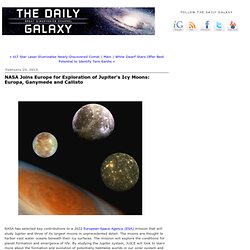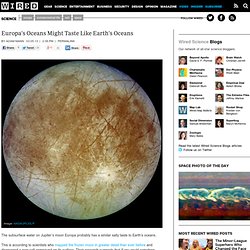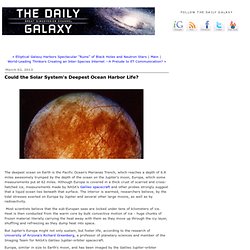

Europa Beckons. Nasa to explore Europa, Ganymede and Callisto. Jupiter’s diverse Galilean moons – volcanic Io, icy Europa and rock-ice Ganymede and Callisto – make the Jovian system a miniature Solar System in its own right.

Ganymede is the only moon in the Solar System known to generate its own magnetic field. JUICE will observe the unique magnetic and plasma interactions with Jupiter’s magnetosphere in detail. “Jupiter is the archetype for the giant planets of the Solar System and for many giant planets being found around other stars,” says Prof. Alvaro Giménez Cañete, ESA’s Director of Science and Robotic Exploration. Under the lead of Lorenzo Bruzzone of Università degli Studi di Trento and the Italian Space Agency, JPL will provide the transmitter and receiver hardware for a radar sounder designed to penetrate the icy crust of Jupiter's moons Europa, Ganymede and Callisto to a depth of about 5 miles (9 kilometers). The solar-powered spacecraft will carry cameras and spectrometers, a laser altimeter and an ice-penetrating radar instrument. Europa's Oceans Might Taste Like Earth's Oceans.
The subsurface water on Jupiter’s moon Europa probably has a similar salty taste to Earth’s oceans.

This is according to scientists who mapped the frozen moon in greater detail than ever before and discovered a new salt compound on its surface. Their research suggests that if you could somehow get to the distant, tiny world, survive the deadly radiation at its surface, drill through its 100-km-thick icy shell, and drink the water without dying, the taste would be somewhat familiar. Europa is an odd dynamic world covered in strange cracks and mysterious salty chemicals. The moon is thought to have a gigantic ocean with two or three times the amount of water on Earth sitting below its frozen exterior.
Because of this, it is considered to be one of the most likely places to find life in our solar system outside of Earth and this new finding definitely kicks the moon’s badassness up a few notches. Long bands filled with reddish-brown material crisscross Europa’s surface. A window into Europa's ocean lies right at the surface. Public release date: 5-Mar-2013 [ Print | E-mail Share ] [ Close Window ] Contact: Brian Bellbbell2@caltech.edu 626-395-5832California Institute of Technology PASADENA, Calif.

Could the Solar System's Deepest Ocean Harbor Life? Europa, similar in size to Earth's moon, and has been imaged by the Galileo Jupiter-orbiter spacecraft.

Its surface, a frozen crust of water, was previously thought to be tens of kilometers thick, denying the oceans below any exposure. The combination of tidal processes, warm waters and periodic surface exposure may be enough not only to warrant life, but also to encourage evolution. With Jupiter being the largest planet in the solar system, its tidal stresses on Europa create enough heat to keep the water on Europa in a liquid state. More than just water is needed to support life. Tides also play a role in providing for life. The mixing of substances needed to support life is also driven by tides.
A Living Ocean on a Jupiter's Moon? Arctic Bacteria Discovered Breeding At Record –15 C. Bacteria that can live and multiply in High Arctic permafrost at temperatures well below the freezing point of water have been discovered by a Canadian-led team of researchers, offering clues about the types of organisms that might exist in similar extreme environments elsewhere in our solar system.

The OR1 strain of the microbe Planococcus halocryophilus is capable of reproducing at –15 C — a record among all known living organisms — and may possibly be able to multiply at temperatures even colder than that, says a study published Wednesday in the ISME Journal. The bacteria remain active at temperatures as low as –25 C. "You look at permafrost, you think of this frozen dead world, but it's not," said Lyle Whyte, a McGill University microbiologist who co-led the study with post-doctoral researcher Nadia Mykytczuk. - Coming up:Nadia Mykytczuk talks to Quirks & Quarks Saturday, May 25 at noon on CBC Radio One NASA collaboration Similar environments on Mars, Europa. Jupiter's Europa moon 'likeliest to have life' Complex and beautiful patterns adorn the icy surface of Jupiter's moon Europa.

US astronomers looking for life in the solar system believe that Europa, one of the moons of Jupiter, which has an ocean, is much more promising than desert-covered Mars, which is currently the focus of the US government's attention. "Europa is the most likely place in our solar system beyond Earth to possess .... life," said Robert Pappalardo, a planetary scientist at NASA's Jet Propulsion Laboratory (JPL) in Pasadena, California. "And it is the place we should be exploring now that we have a concept mission we think is the right one to get there for an affordable cost," he continued. "Europa is the most promising in terms of habitability because of its relatively thin ice shelf and an ocean ... And we know there are oxidants on the surface of Europa. " Advertisement "That way we can get effectively global coverage of Europa by doing many many flybys," Pappalardo argued.